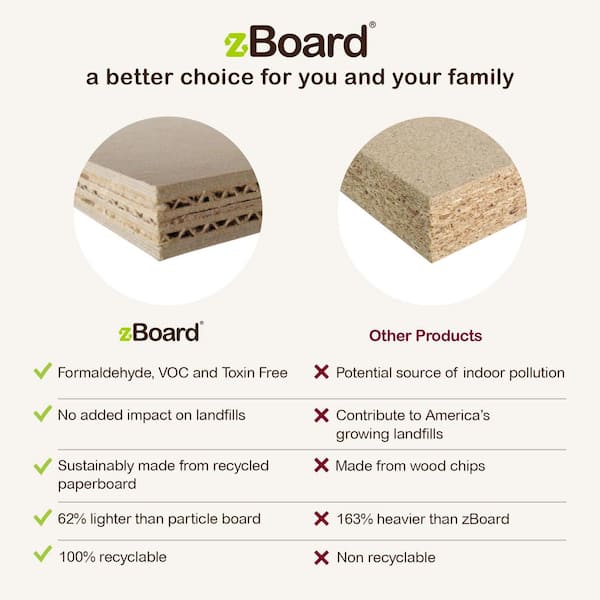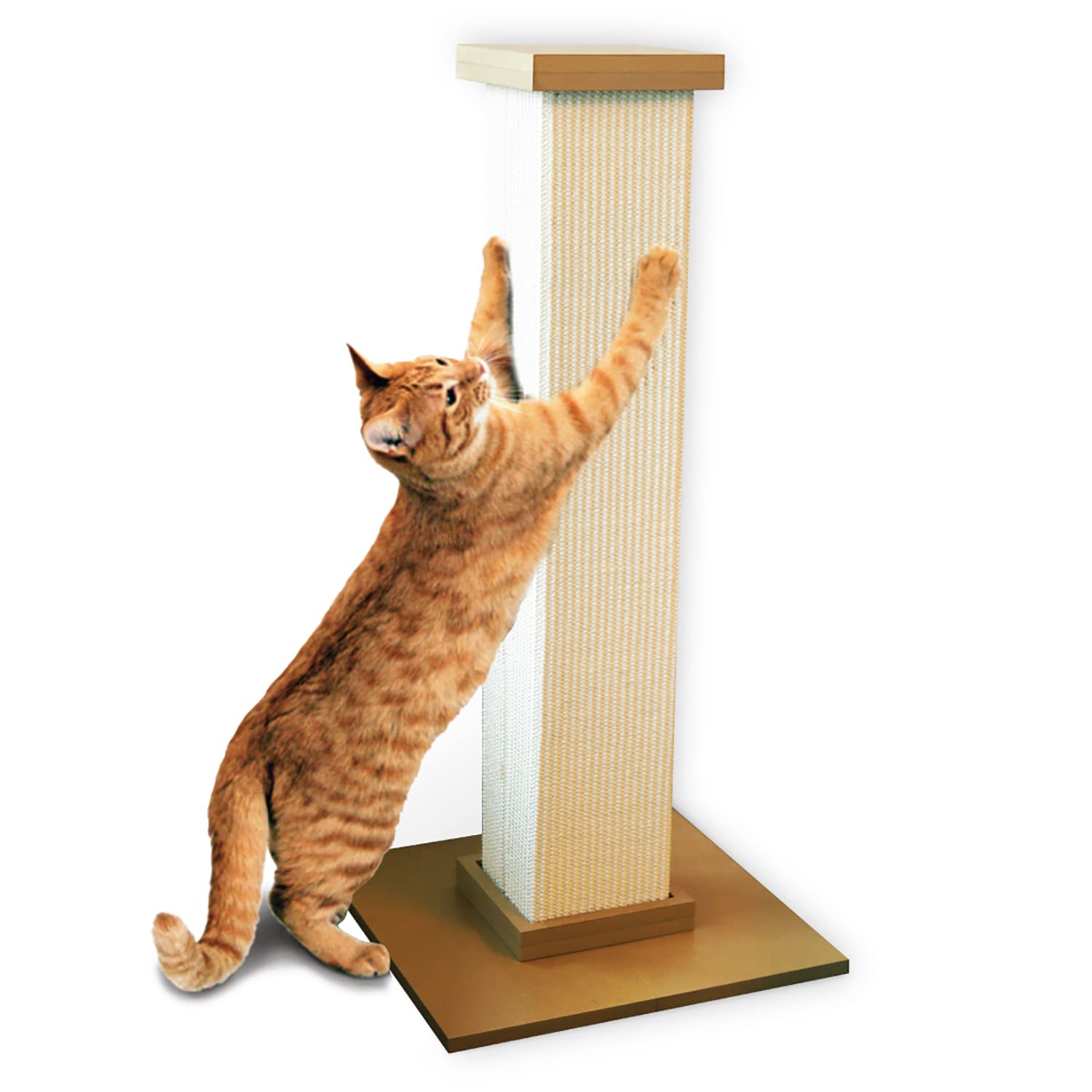Cat scratching posts made of corrugated cardboard are recyclable. Ones combining materials like plastic or metal may not be.
Cat owners often seek eco-friendly options for their furry friends, including recyclable cat scratching posts. These posts serve as an essential outlet for natural feline behavior, helping to keep cats’ claws healthy and saving furniture from damage. The recyclability of a scratching post largely depends on the materials it’s composed of.
Purely cardboard scratchers are a green choice, as they can go straight into the recycle bin once worn out. However, posts containing a mix of wood, plastic, metal, or fabric might require disassembly or special handling for recycling. As sustainability becomes an increasing concern among pet owners, choosing a recyclable scratching post can significantly impact the well-being of the environment.

Credit: www.amazon.com
The Essence Of Cat Scratching Posts
Owning a cat brings joy and a bit of mystery into a home. They leap, they lounge, and they scratch. Cat scratching posts are essential for your feline friend’s well-being. These posts serve to keep your cat’s claws sharp and healthy. They also help protect your furniture. Understanding their role paves the way for a happy cat and a scratch-free home.
Natural Behaviors and Scratching NeedsNatural Behaviors And Scratching Needs
Scratching is a natural behavior for cats. It’s not just a hobby, it’s a need. Scratching allows your cat to flex their paws and maintain their claws. It also helps them mark their territory. This behavior is deeply rooted. Scratching posts channel these instincts into a safe and non-destructive activity.
- Sharpens and trims claws
- Provides exercise and stress relief
- Marks territory visually and with scent
Materials Commonly Used In Scratching Posts
Variety marks the materials in scratching posts. Designers choose them for durability and appeal. Common materials include:
| Material | Benefits |
|---|---|
| Sisal Fabric | Durable, entices scratching |
| Carpet | Soft, familiar for cats |
| Wood | Natural texture, sturdy |
| Cardboard | Eco-friendly, replaceable |
Finding the right scratching post means considering these materials. Look for quality and sustainability. Each material offers a different experience. Cats often show preference for one type over others. Observation can guide the perfect choice.

Credit: www.homedepot.com
Environmental Impacts Of Cat Accessories
As pet owners become more eco-conscious, the environmental impacts of cat accessories gain attention. Cats love to scratch, but what happens to their posts when they’re no longer needed? Understanding the sustainability of cat scratching posts is key in making green choices.
Waste From Pet Products
Pet products contribute to global waste, with many ending up in landfills. Scratching posts, made of various materials, are no exception. Eco-friendly choices can reduce this waste. Here are factors influencing a scratching post’s recyclability:
- Material composition: Posts made from single materials are easier to recycle.
- Construction: Posts with adhesives or mixed materials are harder to process.
- Durability: Long-lasting posts reduce the need for frequent replacement.
Scratching Post Lifecycle
From creation to disposal, scratching posts have a lifecycle that impacts the environment:
| Stage | Environmental Impact |
|---|---|
| Manufacturing | Resources used, energy consumed, and emissions released |
| Usage | Longevity can reduce overall footprint |
| End-of-Life | Landfill space taken if non-recyclable |
By choosing scratching posts made from recyclable materials, cat owners can positively affect these stages.
Recyclability Of Scratching Posts
For cat owners, scratching posts are essential. They save furniture from sharp claws. But what happens when they wear out? Are they recyclable? Understanding the recyclability of these items is crucial for eco-conscious pet parents. Let’s explore whether these posts can join the green cycle.
Breaking Down The Components
Cat scratching posts have various materials. Common ones include cardboard, sisal, wood, and sometimes metal for stability. Each material has a different recycling path. Here is a breakdown:
- Cardboard: Readily recyclable, often biodegradable.
- Sisal: Natural fiber, potentially recyclable.
- Wood: Depending on treatment, it might be recyclable.
- Metal: Highly recyclable, usually accepted in facilities.
However, scratching posts also have non-recyclable elements like adhesives or plastics. Owners need to separate these parts.
Challenges In Recycling Pet Products
Recycling pet products isn’t always straightforward. Multiplex materials in scratching posts create challenges. Facilities might not accept them due to:
- Complex disassembly needed.
- Contamination from pet use.
- Lack of specialized recycling programs.
But don’t worry! Options include:
- Upcycling: Turn old posts into new DIY projects.
- Composting: For posts with natural, untreated materials.
- Drop-off programs: Some stores take back pet products.
Before tossing, check local guidelines or reach out to vet clinics and shelters; they may repurpose your old post.
Eco-smart Choices For Feline Friends
Keeping cats happy is important. A good scratching post can save your furniture. It’s better for the planet too, if you pick the right one. Let’s explore how to choose a scratching post that’s good for your cat and the Earth.
Selecting Sustainable Materials
Cats love scratching. Choosing a recyclable scratching post helps our planet. Look for these materials:
- Cardboard: Lightweight and recyclable.
- Sisal: A natural fiber that’s tough and compostable.
- Wood: Sturdy and comes from renewable forests.
These materials are eco-friendly choices for your cat.
Durability Vs. Biodegradability
Long-lasting posts mean less waste. But, they should also be earth-friendly when it’s time to replace them. Consider:
| Material | Durability | Biodegradability |
|---|---|---|
| Solid Wood | Years | Yes |
| Recycled Plastic | Good | Sometimes |
| Cardboard | Months | Yes |
Good scratching posts mix durability with eco-safety. They last longer and reduce waste. Always choose one that can go back to the earth safely.
Diy And Recycling Initiatives
Recycle or upcycle? This question looms large for eco-conscious cat owners. Good news: creative DIY projects transform used scratching posts, making new, fun options for felines and aiding the environment. Read on to discover how homemade posts and community-driven programs can give old scratchers new life.
Homemade Scratching Posts
Making a scratching post at home is simple and sustainable. Here’s how:
- Gather materials – Use cardboard, wood, or old carpets.
- Design creatively – Cats love variety; combine materials for more fun.
- Assembly – Secure with non-toxic glue or sisal rope.
A DIY scratching post not only recycles materials but also adds a personal touch to your cat’s play.
Upcycling And Community Programs
Upcycling turns waste into worth. It’s about reimagining rather than discarding.
| Material | Programs | End Product |
|---|---|---|
| Old Scratchers | Local Shelters Participating | New Community Posts |
| T-shirts/Fabrics | Upcycling Workshops | Revamped Scratching Surfaces |
Join a local upcycling group or check for shelter programs. They often welcome homemade donations to support animals in need.
The Future Of Eco-friendly Pet Products
Cat owners adore their furry friends and often express this love by providing accessories like scratching posts. Yet, the environmental impact of pet products is becoming a growing concern. Eco-friendly pet products are not just a trend; they signal a shift towards a more sustainable approach in pet care. The future shines brightly for eco-friendly pet products as innovations emerge and consumer demand grows, driving the market towards sustainability.
Innovations In Scratch Post Design
New designs are changing how we think about cat scratching posts. Manufacturers now prioritize recyclability and the use of sustainable materials. From bamboo and recycled cardboard to organic catnip, products are evolving. These innovations address environmental concerns while ensuring cats have a healthy outlet for their natural scratching instincts.
- Bamboo frames for durability and sustainability
- Recycled cardboard structures that can be easily composted
- Use of non-toxic, soy-based adhesives
- Scratch pads infused with organic catnip for extra appeal
Influence Of Consumer Demand On Sustainability
Consumer demand has a powerful impact on the pet products market. Shoppers are now more informed and often choose products that are kinder to the planet. This shift prompts companies to invest in sustainable practices and materials. As a result, more eco-friendly options become available for pet owners who want to make responsible choices.
- Increasing availability of recyclable scratching posts
- Enhanced product transparency regarding materials used
- Rising popularity of products with a low carbon footprint
- Customer reviews influencing eco-conscious purchasing decisions
Consumer choices drive companies to innovate and create sustainable pet products. The reciprocal nature of this relationship highlights the importance of responsible consumerism in shaping a greener future.

Credit: www.petco.com
Frequently Asked Questions For Are Cat Scratching Posts Recyclable
Can Cat Scratching Posts Be Recycled?
Yes, cat scratching posts made from cardboard, sisal, and wood can often be recycled. Disassemble parts and sort materials for proper recycling. Consult local recycling guidelines for specifics.
What Materials Are In Cat Scratching Posts?
Most cat scratching posts contain cardboard, sisal rope, wood, and sometimes carpet. They’re designed for durability and feline enjoyment, using materials cats love to scratch.
How To Dispose Of Old Cat Scratching Posts?
Dispose of old cat scratching posts by recycling. Remove non-recyclable components first. Alternatively, donate to animal shelters if in good condition, or repurpose as garden stakes or DIY projects.
Are Cardboard Scratching Posts Eco-friendly?
Cardboard scratching posts are eco-friendly as they’re typically made from recycled materials and can be recycled again after use. They provide a sustainable option for cat owners.
Conclusion
As cat owners, we face unique recycling challenges. Thankfully, most cat scratching posts can join eco-friendly practices. By choosing recyclable materials and knowing disposal options, we ensure a greener footprint. Remember, sustainability starts with informed choices, so let’s do right by our feline friends and the planet.



